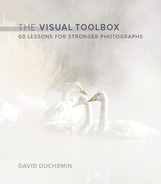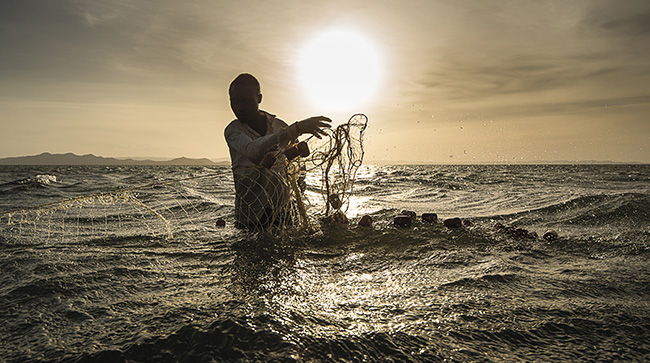Lesson 29. Light: Backlight
Back one last time to our imagined scenario in the field. Now keep walking to the right, and walk until the sun is directly in front of you, though it’s partly obscured by the leaves of the tree. The tree is now completely backlit. Standing in the shadow of the tree itself now, you look up to see the red leaves of the tree ablaze with the light as it streams through the leaves instead of bouncing off them. The grass in the field around you is the same—an impossible green, like it’s lit from within. Dust motes dance on the wind, more visible than you remember them before, lit, like the grass, with transmitted light. The trunk of the tree is dark, almost black, without depth or texture, but if you look carefully you’ll see the last licks of light as they form a halo of rim light around the tree, outlining its inky black silhouette. You make another photograph.
Nikon D3s, 26mm, 1/1000 @ f/11, ISO 400
This fisherman in Northern Kenya is backlit by the setting sun, creating mood and mystery that side or front light would not have done.
If I could photograph only one kind of light for the rest of my life, it would be low natural backlight. Low in the sky, the sun’s light is warm, the shadows are long, and it’s harder to avoid lens flare, which to many is a liability but to me often adds to the magic. Backlight is harder to work with, and it usually takes me a couple of guesses to get my exposure right. But I’ve gone from avoiding it to wrestling with it, to seeking it out for the mood and emotion it creates. It’s not remotely appropriate for every subject, and there are stories aplenty out there that should be told with other light, but the stories I seem to resonate the most with all seem best told with backlight. There’s nothing to know about light—backlight or otherwise—that you yourself can’t learn from observation and experimentation—so get out there and play with it. Here are a few thoughts about technique:
• Choosing a wide aperture will create a look consistent with the dreamy mood that backlight can give. It’ll also exaggerate lens flare, if you like that kind of thing.
• I know you still have your camera in Manual exposure mode, but just in case you slipped it back to a Program mode, it’ll be easier to work in Manual.
• If you’re shooting portraits, you probably don’t want the faces to be too dark, so it’s going to be easier to shoot with the histogram to the right, but you should pay attention to which highlights blow out. Shooting toward a background other than the open sky will give you more drama.
• Moving around will help. You’ve got three choices with the sun—to hide it behind something like your subject, to allow it to peak out or be visible entirely in the frame, or to keep it out of the frame. All three will create different aesthetics. Behind your subject the sun is likely to create a beautiful rim light. Peeking out slightly, you can create an edge-cut sun effect—crank your aperture down to f/16 and you can make a starburst of it.
• Autofocus systems work on contrast, and backlit situations are usually quite low contrast and harder to focus. They can be hard to see in, too, which makes switching to manual a little harder. Try moving slightly so the sun is obscured, find focus, and then reframe. Or have someone flag your lens, blocking the light, while you focus. However you do it, a little patience is helpful. There’s nothing wrong with your camera; it just struggles with this kind of light.
• Look for scenarios with dew, haze, rain, dust, high grass, or anything else that will pick up the light, transmit or diffuse it, and add mood to your work.

